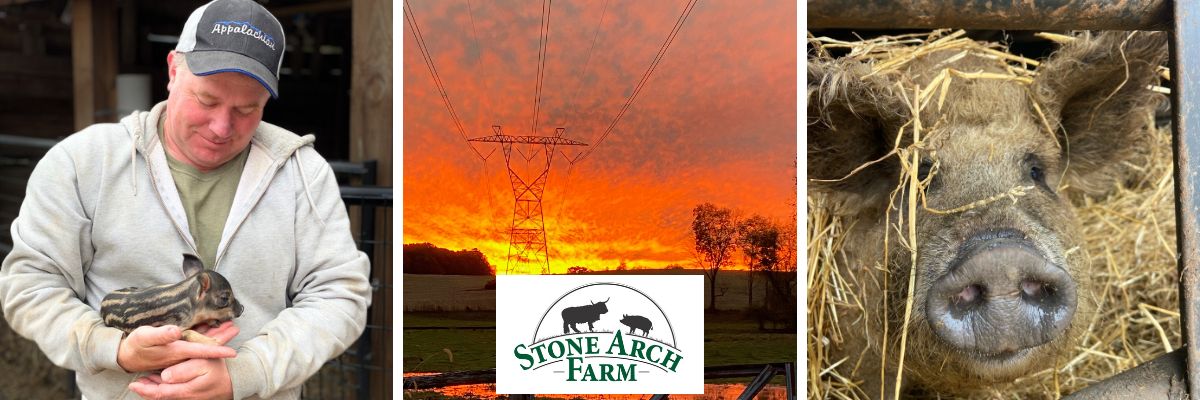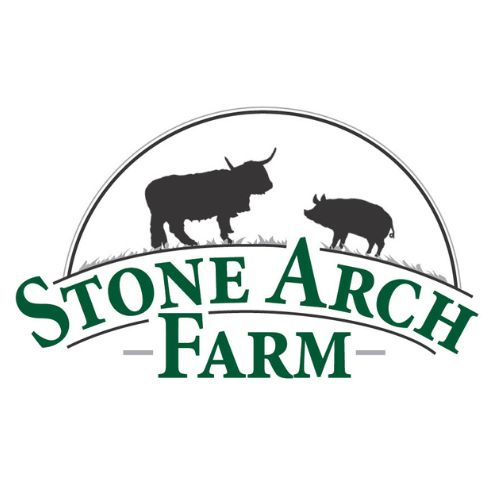About Stone Arch Farms
Through proper animal husbandry, Stone Arch Farm raises heritage breed Mangalitsa pigs. Originating in Hungary, Mangalitsa pigs, also called "hairy pigs" or "hairy sheep" (derives from Serbian language) have a striking physical characteristic that sets them apart from other pig breeds—their dense, curly fleece, reminiscent of a sheep's coat. This woolly covering serves as excellent insulation, allowing them to thrive in colder temperatures and making them well-suited for outdoor rearing in Lancaster County.
Our 100% purebred Mangalitsa pigs consist of all three types: blonde, red and swallow-bellied. One of the most appealing aspects of raising Mangalitsa pigs is their superior meat quality. The breed is renowned for its marbled, succulent, and flavorful meat, which is often compared to the highly prized Japanese Wagyu beef. The high fat content in the meat results in unparalleled tenderness and a unique taste profile that sets it apart from conventional pork. The Mangalitsa's distinctive flavor makes it a preferred choice for thoughtful chefs and food enthusiasts who value rare ingredients.
Our Mangalitsa pig's exceptional fat quality makes it highly versatile in the kitchen. Mangalitsa fat has a low melting point, rendering it ideal for creating lard, which possesses unmatched cooking properties. Mangalitsa lard enhances the texture, flavor, and aroma of dishes, making it a staple ingredient in traditional sausage and charcuterie applications. We like to call it "liquid gold". Additionally, the breed's fat composition is rich in monounsaturated fats, which are considered heart-healthy and have a more favorable impact on cholesterol levels.
From a sustainability standpoint, raising Mangalitsa pigs can be advantageous. Their ability to utilize Stone Arch Farm pastures and forage effectively reduces the reliance on concentrated feeds (we supplement with a local non-gmo corn feed). Additionally, their hardiness and resilience enable them to adapt well to Lancaster County weather all year long. The Mangalitsa pigs raised on Stone Arch Farm pastures with their distinctive appearance, exceptional meat quality, and culinary versatility make it highly sought after by both chefs and consumers.
HamProducts found: 1
Please sign in so that we can notify you about a reply
Buy Ham Online Directly From Farmers
Ham Near Me
Ham is a classic, flavorful cut of meat made from the hind legs of a pig. Through a curing process, ham is preserved and gains its tender texture and rich flavor. Available in bone-in or boneless varieties, ham is perfect for feeding large groups, holiday dinners, or as a tasty weeknight meal. Whether you're cooking for a special occasion or preparing a week of delicious meals, ham is a versatile, savory option that can be served hot or cold.
Fun Facts:
-
Ham comes from the hind leg of a pig and has been a popular food for centuries. The curing process helps preserve the meat and adds a unique depth of flavor.
-
Smoked ham is a popular choice for holiday meals because it can be quickly reheated and served as-is. It's pre-cooked, saving you time in the kitchen.
-
Cured ham comes in two forms—wet-cured and dry-cured—with wet curing being the most common. The ham is either brined in a saltwater solution or smoked for added flavor.
-
Spiral-cut hams are a convenient choice for large gatherings, as the meat is pre-sliced and easy to serve.
Nutritional Info:
-
Protein: Ham is an excellent source of protein, providing about 18g of protein per 3-ounce serving.
-
Fat: Typically around 15g of fat per serving, depending on the cut.
-
Iron: Like most pork cuts, ham contains iron, which is important for your body’s oxygen transport and energy levels.
-
Vitamins: Ham is a great source of B vitamins, especially B6 and B12, which are essential for brain function and energy metabolism.
Cooking Tips/Recipes:
-
Honey Glazed Ham: A classic holiday favorite. For a sweet and savory twist, glaze your ham with a mixture of honey, brown sugar, and mustard, then bake at 325°F for 10 minutes per pound.
-
Baked Ham with Pineapple: Add pineapple rings on top of your ham for a tropical flair. Bake with a glaze made of brown sugar, Dijon mustard, and pineapple juice for added flavor.
-
Ham and Cheese Sliders: Perfect for lunch or as a party appetizer, use leftover ham to make delicious sliders with Swiss cheese and a buttery mustard sauce.
-
Ham & Bean Soup: Use leftover ham bone and meat to create a hearty, filling soup. Combine with white beans, onions, carrots, and spices for a satisfying meal.
Cooking Temperature:
-
For cooked ham, bake at 325°F for 10 minutes per pound until it reaches an internal temperature of 140°F.
-
Partially cooked ham: Plan for around 20 minutes per pound until the internal temperature reaches 160°F.
-
For spiral-cut hams, simply heat until warm, as they are usually fully cooked.
Meat Delivery:
Order your ham directly from trusted farms and butchers, and have it delivered straight to your door. Skip the grocery store and enjoy premium, locally-raised pork from farms committed to quality and sustainability. Whether you're serving it at a holiday meal, preparing a week of delicious dinners, or looking for the perfect cut to feed a crowd, ChopLocal has your needs covered with high-quality ham delivered directly to your home.


